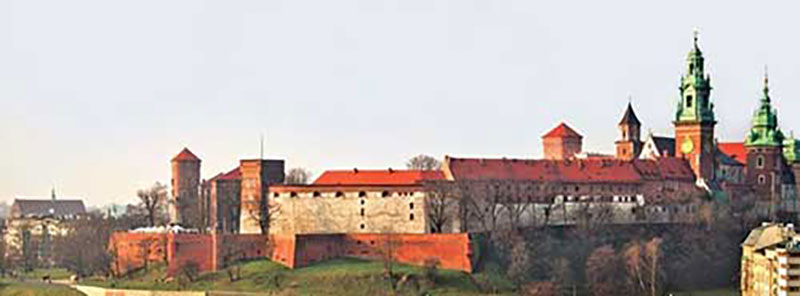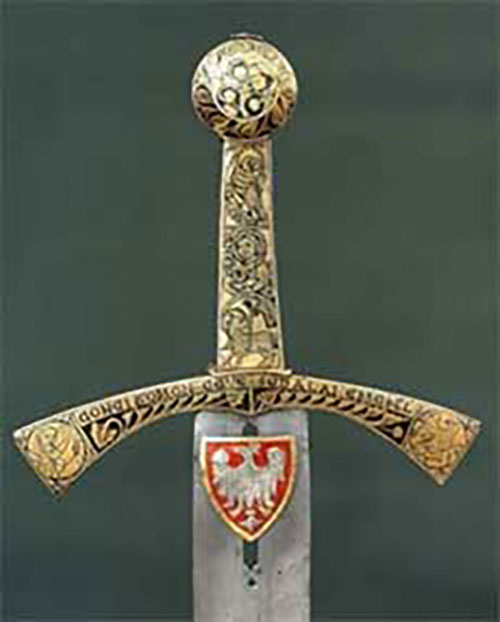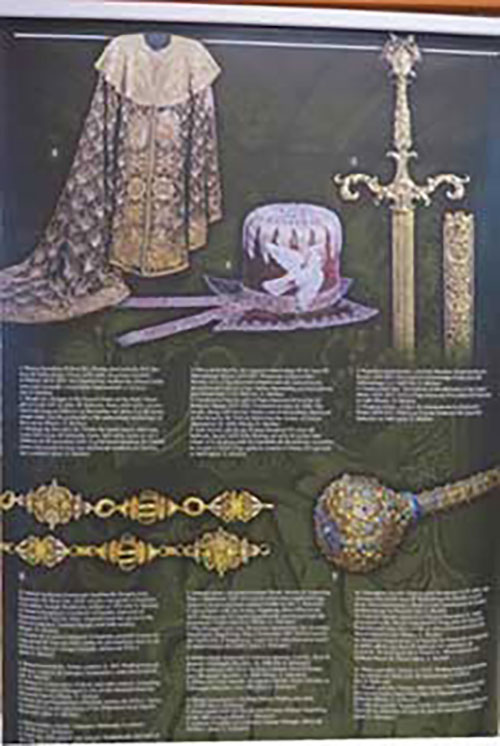by Steven Schwinghamer, Historian
(Updated January 28, 2022)

The Royal Castle of Wawel in Krakow, Poland, housed a state art collection that included some of the most precious cultural artifacts of the nation. In the spring of 1939, the staff of Wawel Castle began to prepare against the possibility of war by constructing cases and cylinders suitable for moving some of the key items of the collection.[1] As tensions rose, the castle closed to the public and the museum’s staff packed the objects and placed them in an air raid shelter. On September 3rd, 1939 — a few days after the German invasion of Poland — staff from the castle began a journey to safety with the key items packed for safekeeping. Travelling by peasant’s carts, by trucks and by commandeered barge through the war-torn countryside of Poland, the collection and its custodians arrived at the border of Poland after two weeks.[2] The news of the Soviet attack on Poland made their initial plan of finding safety within their own country seem impossible, so they joined a large number of refugees at a border bridge into Romania and escaped to the embassy in Bucharest.[3] After exploring options for storing the collection in Romania, Switzerland and the Vatican, the curatorial staff elected to remove the treasures to France.

Credit: Consulate of the Republic of Poland
After a sea voyage through the Mediterranean that included interdiction by a British warship and a two-week stay in Malta, the collection and its guardians arrived in Marseilles and made their way to Aubusson, arriving in January of 1940. A factory there had been prepared to store the French State Art Collection.[4] Within six months, war was underway in Western Europe and its caretakers were again warned to prepare the collection to move before it was overtaken by war—this time, across the Atlantic.[5] After brazenly running port security in France and sleeping on the floor of an overcrowded ship with the Coronation Sword at hand in case of sinking, the curators brought their collection through Falmouth and to the Polish embassy in London. Plans were put in place very quickly to bring the materials to Canada in a convoy, and early on the morning of 4 July 1940, the collection and its caretakers sailed with the Free Polish Ship Batory in a convoy that included Monarch of Bermuda, Sobieski and Revenge and Bonaventure as escort ships.[6]
Arrival in Canada
This convoy crossing of early July 1940 might be one of the most remarkable of the war: the priceless Polish treasures were traveling in the company of one of the early groups of British children evacuated from the dangers of the war, gold and securities from Britain estimated at a value in 1940 of 450 million pounds and a contingent of Canadians returned from service in Europe.[7] From bewildered British children to wounded soldiers, from broken boxes spilling golden sovereigns and classified Polish wireless equipment to the cases containing original compositions of Chopin, this was definitely a unique occasion for the port of Halifax. Given the gravity and variety of his charges in the convoy, the passenger ships’ arrival at Pier 21 on 12 July 1940 was described by Admiral Archer, the commander of Revenge, as a great relief.[8] Following a trip inland on a secured train, the collection rested in facilities of Canada’s National Archives, a records storage building at the Experimental Farm in Ottawa, until 1945.[9] In that time the collection grew, as materials from the Polish display at the 1939 World’s Fair in New York were added to the holdings.[10]
The collection had been in the care of Jozef Polkowski and Stanislaw Zaleski throughout this odyssey, and, as Gordon Swager points out in his study, The Strange Odyssey of Poland’s National Treasures, 1939-1961, these two curators “found themselves new arrivals… each had left behind a wife and son about whom they had received no news.”[11] Further to their personal hardship, the Polish government-in-exile that had commissioned their mission was undone by Soviet military and diplomatic advances in Europe. During 1945, Zaleski and Polkowski took action by moving two trunks of material to the vaults of the Bank of Montreal in Ottawa.[12] These included all the manuscript material, the Coronation Sword of the Polish Kings, a Gutenberg Bible and thirty-two original manuscripts of Chopin’s compositions, among other objects.[13] The other items were distributed, with a further 24 trunks and cases moved to Sainte Anne de Beaupre Monastery in Quebec City, and eight trunks moved to the Monastery of the Precious Blood of Jesus in Ottawa.[14] Before the representatives of the new Polish government arrived to recover the art treasures and gold that had been conveyed to Canada, Zaleski and Polkowski had moved all but the smallest part of the collection out of the Records Storage Building and into the safety of arrangements that might not be breached without their participation.

Credit: Consulate of the Republic of Poland
Religious, diplomatic and political negotiation to gather and return the collection to Poland spanned more than fifteen years after the end of the Second World War. The cultural significance of the items, and in particular their relationship to the history of a vital and independent Poland, was highlighted repeatedly during that time. One notable example of this was a photo essay by Yousuf Karsh in December 1953, published in Life and in Maclean’s.[15] The importance of the items underscored the strong desire of Polish cultural and political leaders to have them returned, and the slow process in Canada—partly a product of Cold War and religious tensions—only reached a resolution in 1961, more than twenty years after the arrival.
- Gordon Swager, The Strange Odyssey of Poland’s National Treasures, 1939-1961 (Toronto: Dundurn, 2004), 17.
- Statement of Dr Stanislaw Swierz Zaleski, Ottawa, 20 November 1946. Library and Archives Canada, RG 25 Volume 2803 File 837-40, 1.
- Swager, 29.
- Swager, 44; Zaleski, 2.
- Zaleski, 3.
- Alfred Draper, Operation Fish (Don Mills, Ontario: General Publishing, 1979), 215; Zaleski, 3-4; Swager, 55.
- Draper, 215; Directorate of Movements, “Batory W-12”, July 1940, RG 24, File HQS-63-303-12, Library and Archives Canada.
- Draper, 219.
- Zaleski, 5.
- Swager, 62.
- Swager, 65.
- Zaleski, 5.
- J A Chapdelaine, Assistant Under-Secretary of State for External Affairs, to General Manager, the Bank of Montreal, Head Office, Montreal; Ottawa, 11 June 1955; Library and Archives Canada, RG 25 Volume 2803 File 837-B-40, 1.
- Zaleski, 5,7.
- Secretary of State for External Affairs, Canada to Canadian Delegation to the United Nations General Assembly, New York; 3 December 1953; Library and Archives Canada, RG 25 Volume 2803 File 837-B-40, 1.
